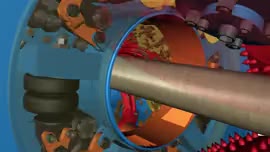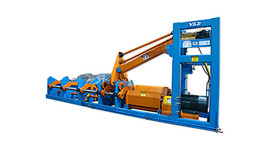Debarkers, Hogs & Butt Flare Reducers: Log and stem debarking and hogging equipment.
Click on Links Below for Detailed Info.
Functional Description:
Debarkers:
Debarkers are utilized to remove the bark from logs or stems (trees) prior to sawing or chipping. There are basically four types of log debarkers: ring debarker, drum debarker, Rosser head debarker and flail debarker.
Ring Debarkers: Logs or stems are singulated and fed linearly into the debarking system. There usually is a centering infeed in front of the debarkers. This infeed centers the log to the center of the ring.
The debarker has infeed rolls to guide and feed the log or stem into the rotor. These rolls can be spike rolls or herringbone rolls. Typically there will be one or two sets of these rolls. The ring, or rotor, rotates around the log as it is fed through the debarker. There are tool arms on the ring that are pressurized, typically with air bags. This pressure squeezes the tool tips against the bark and pulls the bark away at the cambium layer. Debarkers can have a single ring or dual rings. There are outfeed rolls, the same as the infeed rolls, to pull the log or stem out of the debarker. Ring debarkers are primarily used in high speed softwood sawmill applications.
Drum Debarkers: Logs or stems are batch fed linearly into the drum debarker. The drum rotates and tumbles the logs and the bark is removed by rubbing against the drum walls and other fibre in the drum. A variation to the drum debarker is the Fuji King and Brunette Industries reclaimer debarkers. These are bin type debarkers utilizing longitudinal rolls, or rotors, with attachments using a combination of mechanical and log-to-log contact to remove the bark. Drum debarkers are primarily used in larger whole log chipping applications.
Rosser Head Debarkers: Singulated logs are rotated in a cradle with driven rollers while a spinning cutter head passes over the log and moves along its length. The Rosser head debarker works similar to a lathe in the method it removes bark. Rosser head debarkers are primarily used in slower speed operations, in hardwood mills or on larger crooked logs.
Flail Debarkers: The flail debarker consist of chains or other flexible materials mounted on a rotating shaft that are flung and whipped against the logs. This hammering action loosens and removes the bark from the logs. Flail debarkers are primarily used in bush chipping operations.
Butt Flare Reducers:
A butt flare reducer’s turns unwanted logs into valuable timber. Benefits of removing flared log butts include cleaner chips because of removal of bark inclusions, improved productivity and increased lumber recovery because of more accurate scanning and positioning.
The butt flare reducer removes the flare off the butt of stems and logs. This reduces damage to the debarker. By removing the flare with a butt flare reducer, the stem or log lies flatter on the scanner conveyor providing more accurate scanning. Removing the butt flare also reduces stress on the canter chipping heads due to reducing the depth of cut. Removing the flared butt also reduces stress on the board edger when edging side flitches.











